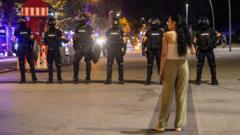In recent weeks, Serbia's long-standing anti-corruption protests have transformed significantly, moving away from traditional rallies to adopting roadblock tactics. This shift comes as the protests enter their ninth month, a response to the students who had previously led the movement stepping back from their leading role. In light of the government failing to heed their demand for fresh elections, these student leaders urged the public to engage in "civil disobedience," resulting in citizens utilizing improvised barriers like dustbins and chairs to block major junctions in cities including Belgrade, Novi Sad, and Nis.
Tensions have escalated with multiple clashes between police and protesters, leading to numerous arrests and accusations against law enforcement for using excessive force. Various societal groups, from journalists to the Serbian Orthodox Church, have condemned the police's conduct, while the EU has characterized the police actions as "acts of hatred and violence."
This wave of protests can be traced back to the tragic collapse of a canopy in Novi Sad last November that resulted in 16 fatalities, fueling public outrage over corruption and mismanagement under Vucic. While the protests initially prompted the resignation of a prime minister, many are now questioning how effective the new tactics will be compared to the past months of demonstrations.
Looking back at the history of protest in Serbia, some leaders liken the current movement to the successful student-led demonstrations against the late President Slobodan Milosevic, yet the present scenario is marked by a stronger position for Vucic and his party. While protesters call for changes through the electoral process, Vucic has stated that no elections will be held until December next year, raising questions about how long the public’s frustration will continue to manifest on the streets. As summer approaches, the potential for rising tensions remains palpable.
Tensions have escalated with multiple clashes between police and protesters, leading to numerous arrests and accusations against law enforcement for using excessive force. Various societal groups, from journalists to the Serbian Orthodox Church, have condemned the police's conduct, while the EU has characterized the police actions as "acts of hatred and violence."
This wave of protests can be traced back to the tragic collapse of a canopy in Novi Sad last November that resulted in 16 fatalities, fueling public outrage over corruption and mismanagement under Vucic. While the protests initially prompted the resignation of a prime minister, many are now questioning how effective the new tactics will be compared to the past months of demonstrations.
Looking back at the history of protest in Serbia, some leaders liken the current movement to the successful student-led demonstrations against the late President Slobodan Milosevic, yet the present scenario is marked by a stronger position for Vucic and his party. While protesters call for changes through the electoral process, Vucic has stated that no elections will be held until December next year, raising questions about how long the public’s frustration will continue to manifest on the streets. As summer approaches, the potential for rising tensions remains palpable.


















